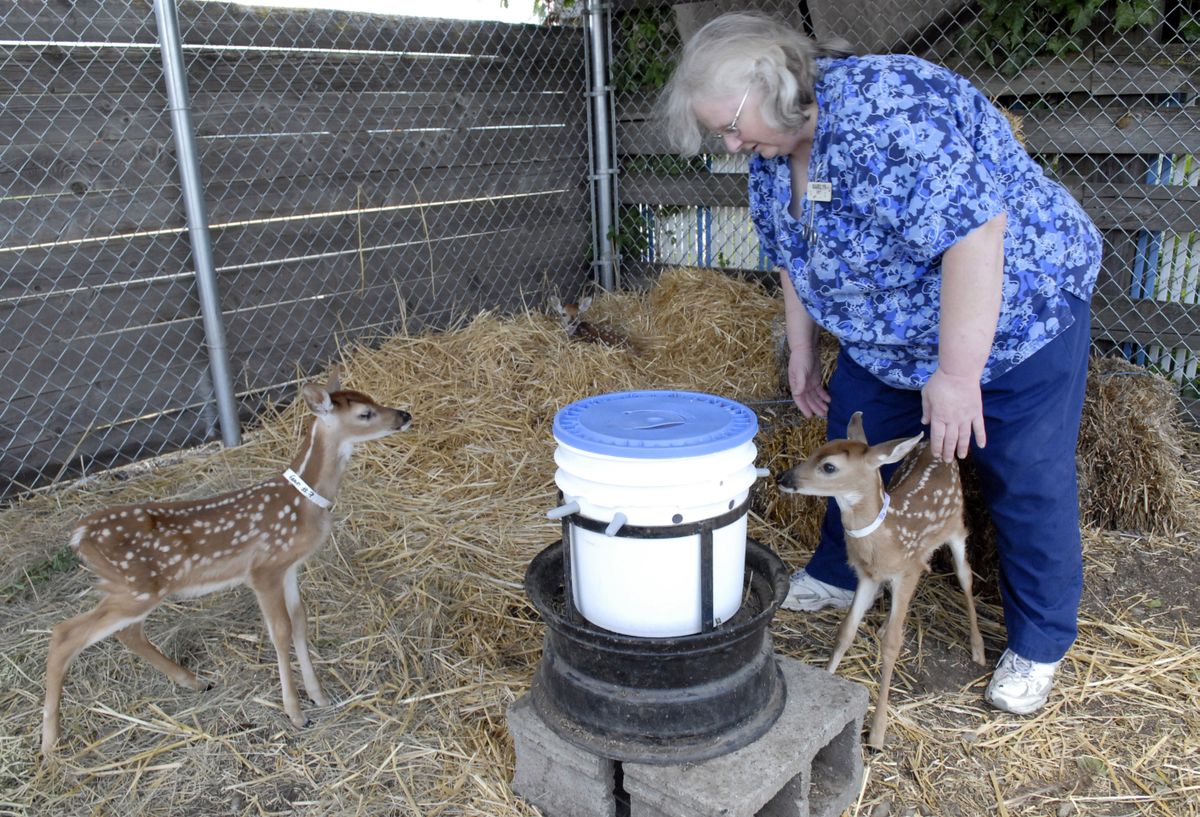Misguided rescues disturb wildlife
Caregivers say hidden young deer are often mistaken for orphans

Wildlife rehabilitator Marilyn Omlor works with youngsters needlessly separated from their mothers. They’re victims of a crime, she said: fawn-napping.
Each June, multiple fawns end up at Ponti Veterinary Clinic in Otis Orchards, where Omlor is employed. Some are truly orphaned, but most were plucked from the woods by well-intentioned people who don’t realize that deer hide their fawns and leave the area to browse for hours at a time.
“It’s really hard to make people understand that,” said Omler, who’s caring for four fawns.
A mule deer fawn – a leggy, 3-week-old male – was brought to the clinic after a dead doe was discovered nearby. But the three female whitetails under Omler’s care probably weren’t orphaned, she said.
Omler feeds the fawns goat-milk formula three times a day but says she’s no substitute for a mother deer. The fawns don’t get the antibodies that come with nursing or the chance to learn from an adult deer.
“If you come upon a fawn, look at it, take some pictures and walk away,” she said.
The problem frustrates wildlife agencies.
“People just have a hard time leaving a cute, little fawn alone,” said Chip Corsi, regional supervisor for Idaho Department of Fish and Game in Coeur d’Alene.
“We put the message out every year, but it doesn’t seem to resonate,” said Madonna Luers, a spokeswoman for the Washington Department of Fish and Wildlife.
Over the past two weeks, the department’s Spokane office has fielded an average of six calls a day from people who found fawns in the woods, Luers said. On one day, the office handled 18 fawn-related calls. In most cases, the callers were persuaded to return the fawns to the place where they were found, in hopes that they could be reunited with their mothers.
The birthing season for local deer typically runs from mid-May to late June.
Fawns are born without a scent, which makes them difficult for predators to detect. Mothers leave their fawns for four to six hours at a time, returning to nurse. The absent-mother parenting is a protective mechanism. It keeps does from leading coyotes and cougars to their babies.
“It’s the way their life history works,” said Corsi, of Idaho Fish and Game. “They tuck the little guys away where they can be secure. The behavior has been in place at least since the last ice age.”
Newborn fawns lie motionless in the grass, camouflaged by their spots. They’re vulnerable to fawn-napping during the first 10 days of their life. After that, they’re too fast to catch.
Ponti’s vet clinic takes fawns that can’t be returned to their mothers. The clinic asks for a $100 donation, which helps feed the fawns until they’re old enough to survive on their own.
In late September, the deer are released on 270 acres of private land near Deer Park, which adjoins state-owned property. By then, their spots have faded and they’re eating tree branches and shrubs.
Omlor, the wildlife rehabilitator, is brusquely maternal toward her charges. The animals’ long-term survival depends on a healthy distrust of humans, so she limits her time with them. “I feed, water, clean up and get out,” she said.
The three whitetail fawns froze, trying to disappear into the straw, when Omlor entered the pen with a pail of formula. “Aren’t they dolls?” she asked, admiring their delicate faces and dark eyes. “They’re hunkering down, which is what their mothers teach them to do.”
The mule deer was cheekier. He ambled toward Omlor, sniffing her pant leg and butting up against her. She sighed and frowned.
“I’m afraid this one’s headed for trouble,” she said. “He’s too comfortable around people.”